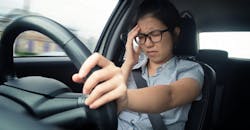Up to a third of Americans experience motion sickness, according to the National Institutes of Health. In a car, the condition tends to flare when you’re a passenger rather than the driver, and it gets worse when you’re engaged in something other than looking out the window such as reading or using a handheld device, for example. This sizeable segment of society could miss out on some of the key benefits of self-driving cars.
“One of the great promises of autonomous vehicles, to give time by freeing us from driving, is at risk if we can’t solve the motion sickness problem,” says Monica Jones, a research scientist at the University of Michigan Transportation Research Institute (UMTRI). “If it’s not mitigated in some way, motion sickness may affect people’s willingness to adopt driverless cars.”
The research team has developed the first repeatable and reliable testing protocol for evaluating specific real-world driving maneuvers and passenger activities that make people carsick. The factors that cause motion sickness in cars are not well understood today.
“Very few studies have been conducted in cars; instead, a lot of the work has been done for sea and air transportation modes, performed in driving simulators or on motion platforms,” Jones says. “These results don’t translate very well to road vehicles.”
Beyond that, previous research hasn’t asked the right questions.
“A lot of scales that exist in the literature are based on nausea,” Jones says. “We need to target comfort levels. Can a passenger use a handheld device while riding? Can passengers be productive with their time?”
The team’s protocol defines how to measure the range of sensations passengers experience and identifies the type of conditions that prompt feelings of motion sickness in cars. Researchers put 52 participants through a series of normal driving maneuvers to develop a scripted route, instrumentation, and measurement protocol.
The testbed consists of:
- A 20-minute test drive developed based on data from a separate real-world driving study. On average, it includes 25 braking events, 45 left turns, and 30 right turns, and is conducted at both 10 to 15 mph and 20 to 25 mph.
- Tasks done on a handheld mini-iPad. At each speed, passengers complete the test drive once with no task, and again while performing a task. Using restaurant reviews, news articles, and local maps, participants answer a range of questions that involve reading comprehension, visual search, text entry, and pattern recognition.
- Sensors record vehicle acceleration and geospatial location and participant’s physiological response, including sweat, skin temperature, and heartrate. Cameras and sensors also record passenger head movement and posture.
- A new motion sickness rating using a 0 to 10 scale, with “0” indicating no motion sickness and “10” indicating “Need to stop the vehicle.”
- An open-ended conversation during the test drive. Once every two minutes or whenever they feel a change, participants describe sensations in their own words, in order to more specifically capture the effects of motion sickness. For each sensation, participants rate the intensity as mild, moderate, or severe.
With the protocol, the researchers hope to develop a mathematical model of motion sickness—one that automakers can use to build vehicles that operate below the threshold. Data from this testbed could inform decisions such as how driverless cars brake and accelerate during turns, for example, or how the seating area and windows are arranged. Different control algorithms and car concepts can be tested and measured, apples-to-apples.
“We have found that passenger responses are complicated and have many dimensions,” Jones said. “Applications of this testbed will result in the data we need to identify preventative measures and alleviate motion sickness in autonomous vehicles.”

